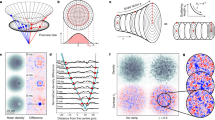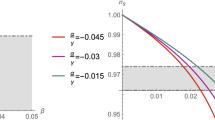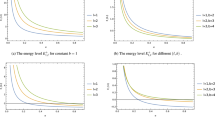Abstract
In the last two decades the anti-de Sitter/conformal field theory (AdS/CFT) correspondence has emerged as a focal point of many research interests. In particular, it functions as a stepping stone to a still-missing full quantum theory of gravity. In this context, a pivotal question is if and how cosmological physics can be studied using AdS/CFT. Motivated by string theory, braneworld cosmologies propose that our universe is a four-dimensional membrane embedded in a bulk five-dimensional AdS spacetime. We show how such a scenario can be microscopically realized in AdS/CFT using special field theory states dual to an ‘end-of-the-world brane’ moving in a charged black hole spacetime. Observers on the brane experience cosmological physics and approximately four-dimensional gravity, at least locally in spacetime. This result opens a path towards a description of quantum cosmology and the simulation of cosmology on quantum machines.
This is a preview of subscription content, access via your institution
Access options
Access Nature and 54 other Nature Portfolio journals
Get Nature+, our best-value online-access subscription
$29.99 / 30 days
cancel any time
Subscribe to this journal
Receive 12 print issues and online access
$209.00 per year
only $17.42 per issue
Buy this article
- Purchase on Springer Link
- Instant access to full article PDF
Prices may be subject to local taxes which are calculated during checkout





Similar content being viewed by others
Code availability
The code used in this study is available from the corresponding author upon reasonable request.
References
’t Hooft, G. Dimensional reduction in quantum gravity. In Salamfestschrift: a collection of talks (eds Ali, A., Ellis, J. & Randjbar-Daemi, S.) 284–296 (World Scientific, 1993).
Susskind, L. The world as a hologram. J. Math. Phys. 36, 6377–6396 (1995).
Aharony, O., Gubser, S. S., Maldacena, J. M., Ooguri, H. & Oz, Y. Large N field theories, string theory and gravity. Phys. Rep. 323, 183–386 (2000).
Cooper, S. et al. Black hole microstate cosmology. J. High Energy Phys. 2019, 65 (2019).
Karch, A. & Randall, L. Open and closed string interpretation of SUSY CFT’s on branes with boundaries. J. High Energy Phys. 2001(06), 063 (2001).
Takayanagi, T. Holographic dual of BCFT. Phys. Rev. Lett. 107, 101602 (2011).
Fujita, M., Takayanagi, T. & Tonni, E. Aspects of AdS/BCFT. J. High Energy Phys. 2011, 43 (2011).
Kourkoulou, I. & Maldacena, J. Pure states in the SYK model and nearly-AdS 2 gravity. Preprint at https://arxiv.org/abs/1707.02325 (2017).
Almheiri, A., Mousatov, A. & Shyani, M. Escaping the interiors of pure boundary-state black holes. Preprint at https://arxiv.org/abs/1803.04434 (2018).
Papadodimas, K. & Raju, S. An infalling observer in AdS/CFT. J. High Energy Phys. 2013, 212 (2013).
Papadodimas, K. & Raju, S. State-dependent bulk-boundary maps and black hole complementarity. Phys. Rev. D 89, 086010 (2014).
Papadodimas, K. & Raju, S. Remarks on the necessity and implications of state-dependence in the black hole interior. Phys. Rev. D 93, 084049 (2016).
Harlow, D. Aspects of the Papadodimas-Raju proposal for the black hole interior. J. High Energy Phys. 2014, 55 (2014).
Hartman, T. & Maldacena, J. Time evolution of entanglement entropy from black hole interiors. J. High Energy Phys. 2013, 14 (2013).
Binetruy, P., Deffayet, C. & Langlois, D. Nonconventional cosmology from a brane universe. Nucl. Phys. B 565, 269–287 (2000).
Padilla, A. Brane World Cosmology and Holography. PhD thesis, Durham Univ. (2002); https://arxiv.org/abs/hep-th/0210217
Gregory, J. P. & Padilla, A. Exact brane world cosmology induced from bulk black holes. Class. Quantum Gravity 19, 4071–4083 (2002).
Gubser, S. S. AdS/CFT and gravity. Phys. Rev. D 63, 084017 (2001).
Savonije, I. & Verlinde, E. P. CFT and entropy on the brane. Phys. Lett. B 507, 305–311 (2001).
Biswas, A. K. & Mukherji, S. Holography and stiff matter on the brane. J. High Energy Phys. 2001(03), 046 (2001).
Verlinde, E. P. On the holographic principle in a radiation dominated universe. Preprint at https://arxiv.org/abs/hep-th/0008140 (2000).
McFadden, P. & Skenderis, K. Holography for cosmology. Phys. Rev. D 81, 021301 (2010).
Bernardo, H. & Nastase, H. Holographic cosmology from ‘dimensional reduction’ of \({\mathcal{N}}=4\) SYM vs. AdS5 × S5. J. High Energy Phys. 12, 025 (2019).
Dong, X., Silverstein, E. & Torroba, G. De Sitter holography and entanglement entropy. J. High Energy Phys. 07, 050 (2018).
Bilic, N. Randall-Sundrum versus holographic cosmology. Phys. Rev. D 93, 066010 (2016).
Randall, L. & Sundrum, R. A large mass hierarchy from a small extra dimension. Phys. Rev. Lett. 83, 3370–3373 (1999).
Randall, L. & Sundrum, R. An alternative to compactification. Phys. Rev. Lett. 83, 4690–4693 (1999).
Karch, A. & Randall, L. Locally localized gravity. J. High Energy Phys. 05, 008 (2001).
Seahra, S. S., Clarkson, C. & Maartens, R. Delocalization of brane gravity by a bulk black hole. Class. Quantum Gravity 22, L91–L102 (2005).
Clarkson, C. & Seahra, S. S. Braneworld resonances. Class. Quantum Gravity 22, 3653–3688 (2005).
Dias, G. A. S. & Lemos, J. P. S. Hamiltonian thermodynamics of d-dimensional (d ≥ 4) Reissner-Nordström-anti-de Sitter black holes with spherical, planar, and hyperbolic topology. Phys. Rev. D 79, 044013 (2009).
Huang, Y., Liu, D.-J. & Li, X.-Z. Superradiant instability of D-dimensional Reissner–Nordström-anti-de Sitter black hole mirror system. Int. J. Mod. Phys. D 26, 1750141 (2017).
Avelino, P. P., Hamilton, A. J. S., Herdeiro, C. A. R. & Zilhao, M. Mass inflation in a D-dimensional Reissner-Nordström black hole: a hierarchy of particle accelerators? Phys. Rev. D 84, 024019 (2011).
Sadeghi, J. & RezaShajiee, V. Quantum tunneling from the charged non-rotating BTZ black hole with GUP. Eur. Phys. J. Plus 132, 132 (2017).
Gouteraux, B. Black-Hole Solutions to Einstein’s Equations in the Presence of Matter and Modifications of Gravitation in Extra Dimensions. PhD thesis, Orsay, LPT (2010); https://arxiv.org/abs/1011.4941
Ghosh, A. & Mitra, P. Temperatures of extremal black holes. Preprint at https://arxiv.org/abs/gr-qc/9507032 (1995).
Andrade, T., Fischetti, S., Marolf, D., Ross, S. F. & Rozali, M. Entanglement and correlations near extremality: CFTs dual to Reissner-Nordström AdS 5. J. High Energy Phys. 04, 023 (2014).
Hawking, S. W. & Ross, S. F. Duality between electric and magnetic black holes. Phys. Rev. D 52, 5865–5876 (1995).
Chamblin, A., Emparan, R., Johnson, C. V. & Myers, R. C. Charged AdS black holes and catastrophic holography. Phys. Rev. D 60, 064018 (1999).
Burikham, P. & Promsiri, C. The mixed phase of charged AdS black holes. Adv. High Energy Phys. 2016, 5864672 (2016).
Maldacena, J. & Qi, X.-L. Eternal traversable wormhole. Preprint at https://arxiv.org/abs/1804.00491 (2018).
Cottrell, W., Freivogel, B., Hofman, D. M. & Lokhande, S. F. How to build the thermofield double state. J. High Energy Phys. 02, 058 (2019).
Martyn, J. & Swingle, B. Product spectrum ansatz and the simplicity of thermal states. Phys. Rev. A 100, 032107 (2019).
Chavanis, P.-H. Cosmology with a stiff matter era. Phys. Rev. D 92, 103004 (2015).
Hovdebo, J. L. & Myers, R. C. Bouncing braneworlds go crunch! J. Cosmol. Astropart. Phys. 0311, 012 (2003).
Kodama, H. & Ishibashi, A. Master equations for perturbations of generalized static black holes with charge in higher dimensions. Prog. Theor. Phys. 111, 29–73 (2004).
Ryu, S. & Takayanagi, T. Holographic derivation of entanglement entropy from AdS/CFT. Phys. Rev. Lett. 96, 181602 (2006).
Hubeny, V. E., Rangamani, M. & Takayanagi, T. A covariant holographic entanglement entropy proposal. J. High Energy Phys. 07, 062 (2007).
Chiodaroli, M., D’Hoker, E. & Gutperle, M. Simple holographic duals to boundary CFTs. J. High Energy Phys. 02, 005 (2012).
Acknowledgements
This work was supported in part by the US Department of Energy, Office of Science, Office of High Energy Physics QuantISED Award DE-SC0019380 and by the Simons Foundation via the It from Qubit collaboration. We thank M. Van Raamsdonk, C. Waddell, D. Wakeham, M. Rozali, S. Cooper, R. Sundrum, R. Bousso, S. Kumar, Y. Wang and J. Maldacena for discussions.
Author information
Authors and Affiliations
Contributions
The authors contributed equally to this work.
Corresponding author
Ethics declarations
Competing interests
The authors declare no competing interests.
Additional information
Peer review information Nature Physics thanks Neven Bilic, Tadashi Takayanagi and the other, anonymous, reviewer(s) for their contribution to the peer review of this work.
Publisher’s note Springer Nature remains neutral with regard to jurisdictional claims in published maps and institutional affiliations.
Extended data
Extended Data Fig. 1 Action difference - Large black hole.
Results for four spatial dimensions (d = 4). We set the outer horizon radius to be r+ = 100, with the AdS length given by LAdS = 1. a, We chose r− = 50 for the inner horizon radius. When the tension T is not too close to its critical value Tcrit = 1/LAdS = 1, the preparation time τ0 is positive (i.e. the solution is Euclidean-sensible) and the action difference ΔI is negative, meaning that the non-extremal phase is always dominant in the path integral. b, For a near-critical brane (we chose a value T = 0.99999 ~ Tcrit for the brane tension), when the black hole is sufficiently close to extremality (i.e. r− → r+), the preparation time τ0 becomes positive, and therefore the Euclidean solution is sensible. The non-extremal phase is already dominant in the ensemble (i.e. the action difference ΔI is negative) well before it happens. The same properties hold also for the small black hole case.
Extended Data Fig. 2 Proper brane trajectory r(λ).
Results for four spatial dimensions (d = 4), where we chose the AdS length to be LAdS = 1. a, Brane radius r(λ) as a function of the brane proper time λ for a subcritical brane of tension T = 0.89. During its trajectory, the brane radius expands to a maximum value r0 larger than the black hole outer horizon r+ = 100, and shrinks to a minimum value \({r}_{0}^{-}\) smaller than the black hole inner horizon r− = 91. b, For larger values of the brane tension (T = 0.99999 ~ Tcrit = 1/LAdS = 1) and a near-extremal black hole (r+ = 100, r− = 99.9), the maximum radius of the brane r0 is larger, and the inversion at the minimum radius \({r}_{0}^{-}\) becomes sharper. In both cases the brane trajectory resembles the one qualitatively described in Fig. 1 of the main paper.
Supplementary information
Supplementary Information
Supplementary discussion, Figs. 1–13 and Table 1.
Rights and permissions
About this article
Cite this article
Antonini, S., Swingle, B. Cosmology at the end of the world. Nat. Phys. 16, 881–886 (2020). https://doi.org/10.1038/s41567-020-0909-6
Received:
Accepted:
Published:
Issue Date:
DOI: https://doi.org/10.1038/s41567-020-0909-6
This article is cited by
-
Holographic complexity: braneworld gravity versus the Lloyd bound
Journal of High Energy Physics (2024)
-
Shift Symmetries and AdS/CFT
Journal of High Energy Physics (2023)
-
Cosmology from random entanglement
Journal of High Energy Physics (2023)
-
Accelerating cosmology from Λ < 0 gravitational effective field theory
Journal of High Energy Physics (2023)
-
Holographic measurement in CFT thermofield doubles
Journal of High Energy Physics (2023)



